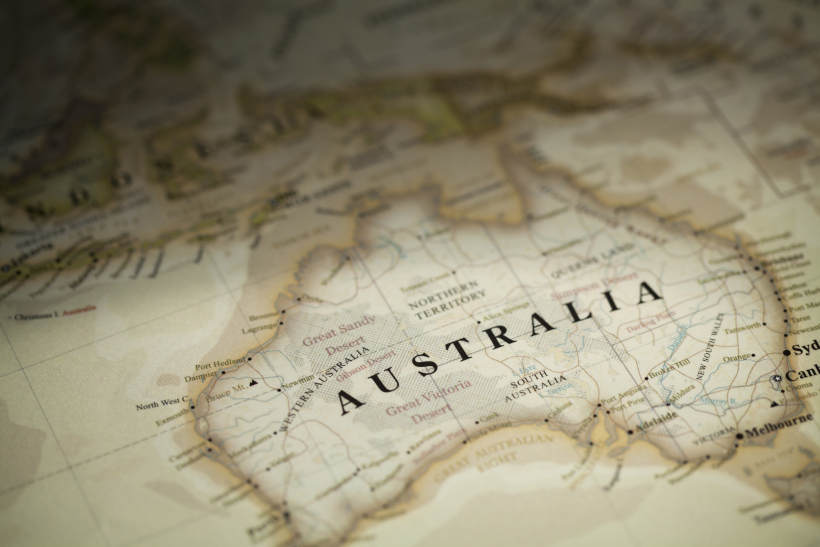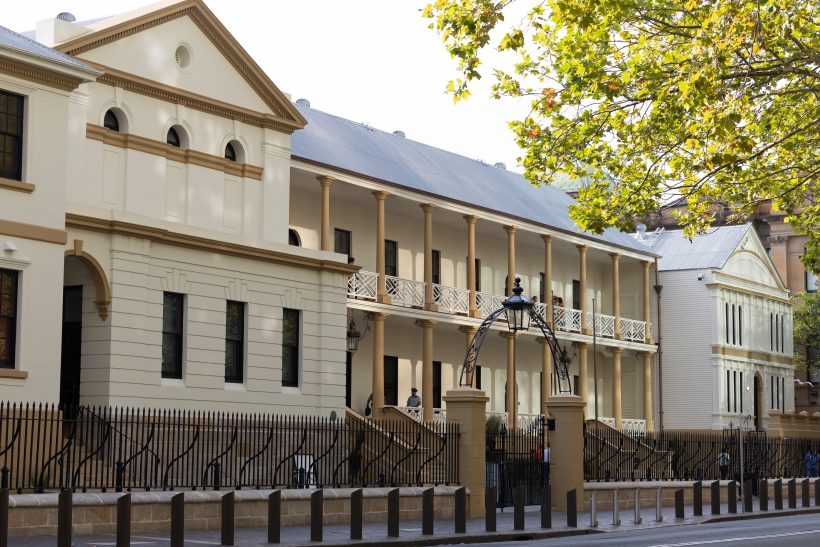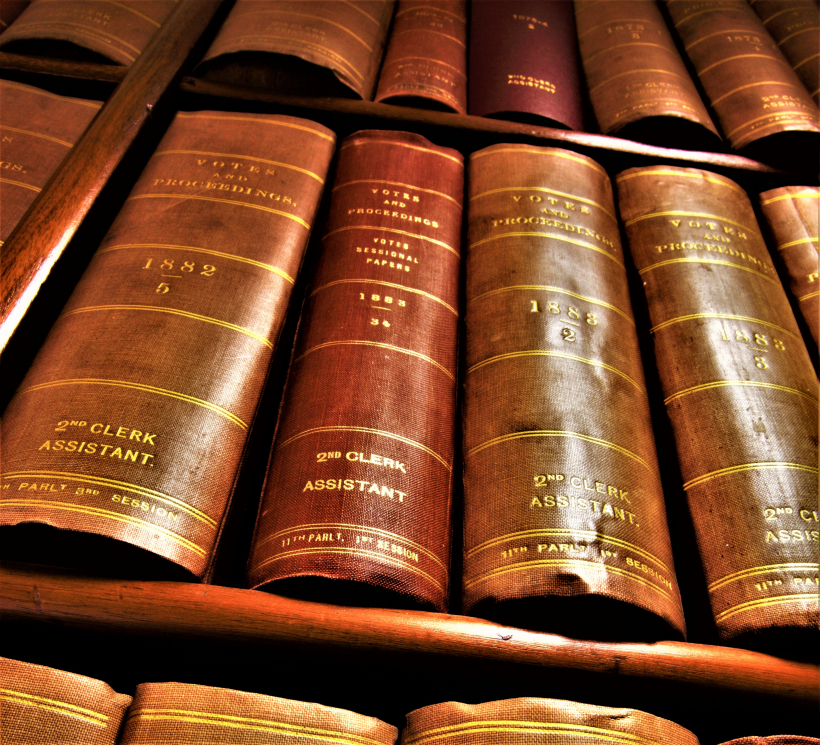Learning Outcomes
- Students will explain the rights and responsibilities of individuals and groups in the democratic process, including the right to vote
- Students analyse and understand how an election is conducted, voting methods and systems; preferential voting, optional preferential voting and proportional and optional preferential proportional voting
- Students will understand how to develop solutions to an issue and actively engage with Australian Democracy
Syllabus Links
Core 4: Law, Society and Political Involvement
Participation in the democratic process
- investigate the rights and responsibilities of individuals and groups in the democratic process, including the right to vote (ACHCK061, ACHCK062)
- explain how an election is conducted and the range of voting methods – first past the post, preferential, optional preferential and proportional
Elections
![]()
Political engagement and participation in elections is the cornerstone of Australian democracy.
As a representative democracy Australia holds open and free elections at all levels of government to choose members that will speak and make decisions on behalf of the people. Voting for Australian citizens 18 years and over is compulsory and they must register to vote.
Enrolment
Federal: AEC https://www.aec.gov.au/enrol/ for Federal elections
State and Local: NSW Electoral Commission https://www.elections.nsw.gov.au/Voters/Enrol-to-vote
Elections in NSW
Australia is a representative democracy. Citizens elect representatives to speak in parliament and make decisions on their behalf. Voting for a person who represents your views allows you to have a say in the laws passed and decisions made by the parliament.


In NSW Section 5 of the NSW Constitution Act 1902 allows the elected Parliament of New South Wales to make laws for the “peace, welfare and good government” of the State.
Usually at the end of a four year term, Parliament is prorogued by the Governor who issues the writs for a general election of the Legislative Assembly, all 93 Members, and 21 Members (half) of the Legislative Council.
What are the writs?
In the electoral context, a writ is a document issued by the Governor and signed by the Premier, commanding the Electoral Commissioner to hold an election. It contains dates for the close of rolls, the last day for nominations by candidates, the polling day and the day the writs are to be returned. The writs for 93 electoral districts in the Legislative Assembly and one writ for the Legislative Council are issued by the Governor and received by the NSW Electoral Commissioner.
In NSW, the Parliament expires on the Friday before the first Saturday in March every fourth year and the writs must be issued within four days of that day. Once the writs have been issued, candidates nominate for election to the Legislative Assembly or the Legislative Council.
Who chooses the order of candidates on the ballot paper?
The Legislative Assembly
The election manager for each electorate conducts a draw of the names of candidates in order to determine the position of candidates on the ballot paper.
The Legislative Council
Prior to an election, the NSW Electoral Commissioner will conduct a draw, determining the order in which groups and ungrouped candidates are shown on length ways across the ballot paper. Each group can choose the order their candidates appear vertically below the line.
Election Day
Elections in NSW are conducted by the NSW Electoral Commission.
“We are legislated to conduct, regulate, and report on general elections and by-elections for the Parliament of New South Wales. We also provide electoral services to local governments”
NSW Electoral Commission
During the campaign candidates speak to voters at a variety of forums, the electoral rolls are prepared, ballot papers for each electorate and for the Legislative Council are printed, polling places are prepared, postal and pre-poll voting is conducted.
On election day voters arrive to choose their electorate members via secret ballot.
Election day is always held on a Saturday so all can get to the polling booths that are open from 8am to 6pm.
At the entrance, representatives of the various political parties and candidates hand out “How To Vote” cards. Voters register on arrival and are marked against the electoral roll and must respond to three critical questions: “What is your name?”, “What is your address?”, and “Have you voted today?”. The voter is then handed two ballot papers – one for the Legislative Assembly and one for the Legislative Council. After completing them they are folded and placed in the allocated ballot boxes.
After the polling booths close the first preference votes are counted and the results are phoned-in to the state tally room where results are recorded on the tally board. Scrutineers for each of the candidates observe the counting.
Once the results are known, the Electoral Commissioner returns the writs to the Governor with all of the names of the candidates that have been elected to the Legislative Assembly and the Legislative Council. This must happen within 60 days of the writs originally being issued.
Did you know?
South Australia and Victoria were the first places to use the secret ballot in 1856. NSW introduced the secret ballot two years later in 1858
The Governor then appoints as Premier the leader of the political party that has won the majority of seats in the Legislative Assembly. On the advice of the new Premier, the new Ministry is appointed. Within seven days of the return of the writs the new Parliament must meet commencing its new four year term.
The 2023 Election
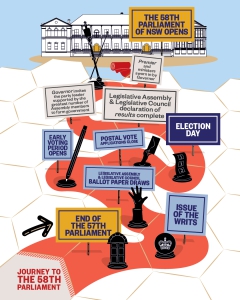
Political Parties
The three main parties in NSW are the Australian Labor Party, the Liberal Party and the Nationals. There are smaller or minor parties such as The Greens, and the Shooters, Fishers and Farmers Party. As a result of optional preferential proportional voting in the Upper House, there are more diverse political parties in the Legislative Council with minor parties represented – Christian Democrats, Animal Justice Party, Pauline Hanson’s One Nation. A Member of Parliament who does not belong to a political party is called an Independent.
How do political parties become part of an election?
For a political party to be registered and contest an election in NSW they must have registered with NSW Electoral Commission at least 12 months before the election and their registration must include the names of at least 750 members (all registered NSW voters) and pay a registration fee of $2,000.
Close to an election, political parties select from their members a candidate for each electorate that the political party wants to contest, including creating a group ticket for the Legislative Council ballot paper. The major political parties usually have a candidate in every Legislative Assembly electorate. Smaller parties will field candidates in many electorates and may also nominate a group ticket for the Legislative Council.
Each candidate can nominate for one Legislative Assembly electorate or for election to the Legislative Council. Independents must be nominated by 15 persons enrolled in the electoral district they wish to contest. They submit a nomination form obtained (from the NSW Electoral Commission) to the Returning Officer before noon on the day of nomination.
At noon, on the day of nomination, the Returning Officer for each electorate conducts a draw of names of all the candidates whose nominations have been accepted in order to determine the position of those candidates on the ballot paper.
Political parties hope to win the majority in the Legislative Assembly (Lower House) so they can form government and put their policies into practice.
Did you know?
An amendment to the Electoral Funding Act 2018 makes it unlawful for a person to make or accept a political donation in the form of cash over $100.
This new category of unlawful political donation came into effect from 1 January 2020.
Electing a Member of the Legislative Assembly
Electoral Map of NSW
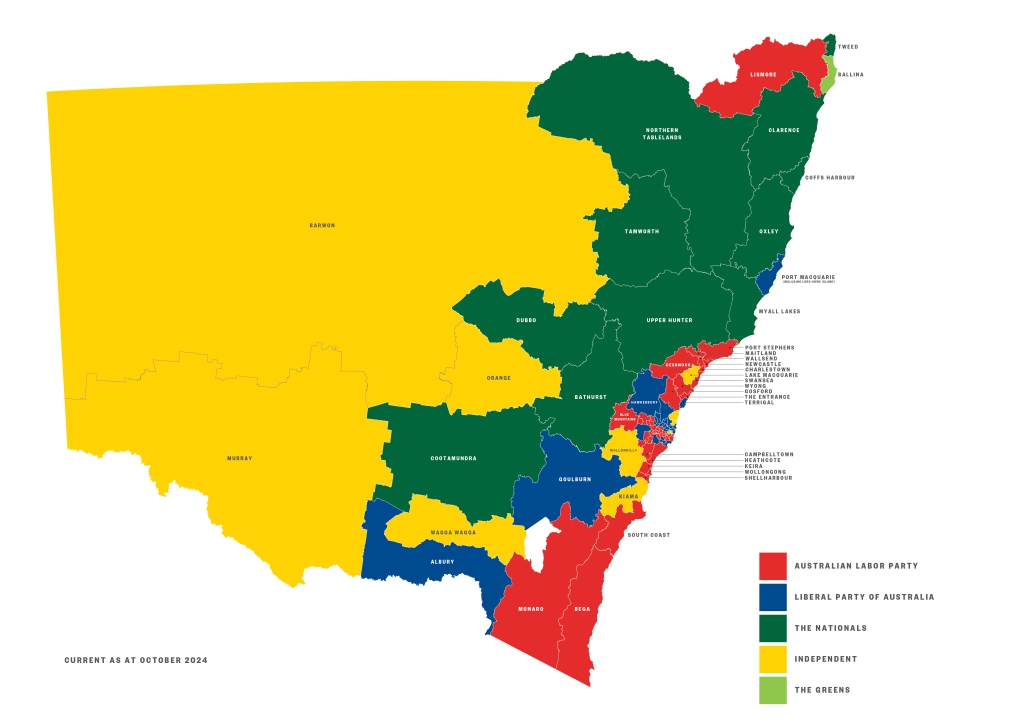
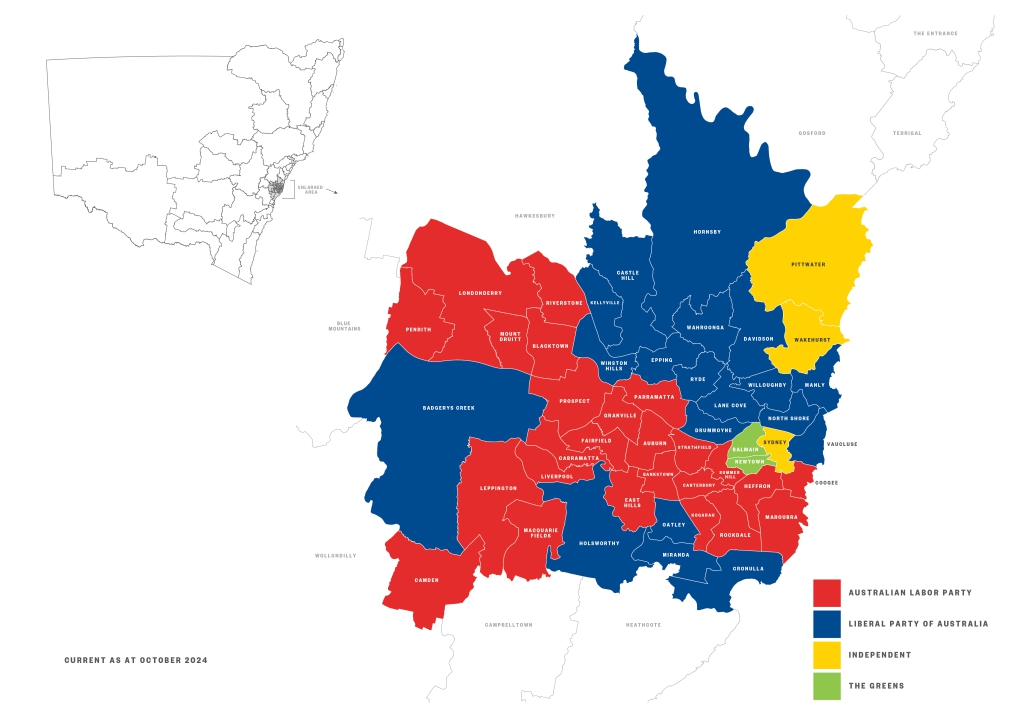
NSW is divided into 93 electorates with one Member of Parliament representing each electorate in the Legislative Assembly. The boundaries of each state electorate are determined by a distribution process, set out in the NSW Constitution which provides for an equal number of voters in each electoral district (allowing for a maximum of 10% variation more or less than the average).
Redistributions occur when more than a quarter of the electoral districts do not have an equal number of voters and after every second election.
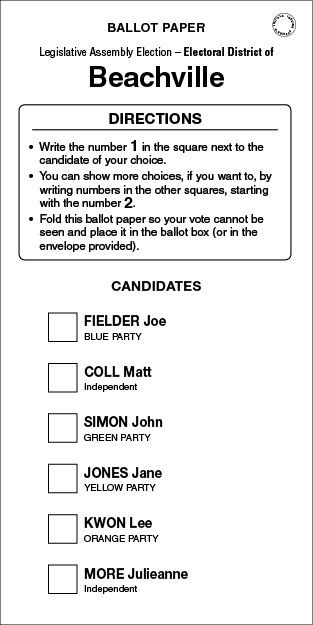
Sample ballot Legislative Assembly ballot paper supplied by NSW Electoral Commission
The Legislative Assembly also known as the Lower House uses optional preferential voting. The voter places the number “1” in the square next to the name of the candidate who is the voter’s first choice. No other vote is necessary but in NSW the voter has the option of allocating as many preferences as there are members on the ballot paper. The preferences are placed in the squares next to the candidates. The order does not matter provided consecutive numbers have been used.
How are preferences decided?
The voter is fully responsible for their preferences and how they are allocated. Political parties hand-out leaflets on how to fill out ballot papers at elections however these are only suggestions.
As preferences are optional in the Lower House, those that have only one preference will be set aside, ‘exhausted’, after the single vote is counted. Those with two votes are exhausted after the second vote is counted, distributed and so on. Those ballot papers which are set aside as exhausted are not classified as remaining in the count reducing the number of votes remaining in the count and also reducing the number of votes required to be elected. The distribution process is repeated, eliminating candidates one at a time until a candidate has more than half the number of the votes left in the count i.e. until a candidate reaches over 50% of the vote or 50% plus 1.
Did You Know?
When a member is elected in the Legislative Assembly to an electorate they represent on average 50,000 voters each.
Electing a Member of the Legislative Council
The Legislative Council consists of 42 Members who represent the whole of NSW in the Parliament. Members are elected on a proportional basis across the whole state, and candidates are presented in a state-wide ballot. Under section 22B of the Constitution Act 1902, Members of the Legislative Council serve a term of eight years which consists of two four-year terms.
Members of the Legislative Council (the Upper House) are elected through an optional preferential proportional representation voting system. Parties or individuals are elected according to the proportion of the total vote they receive.

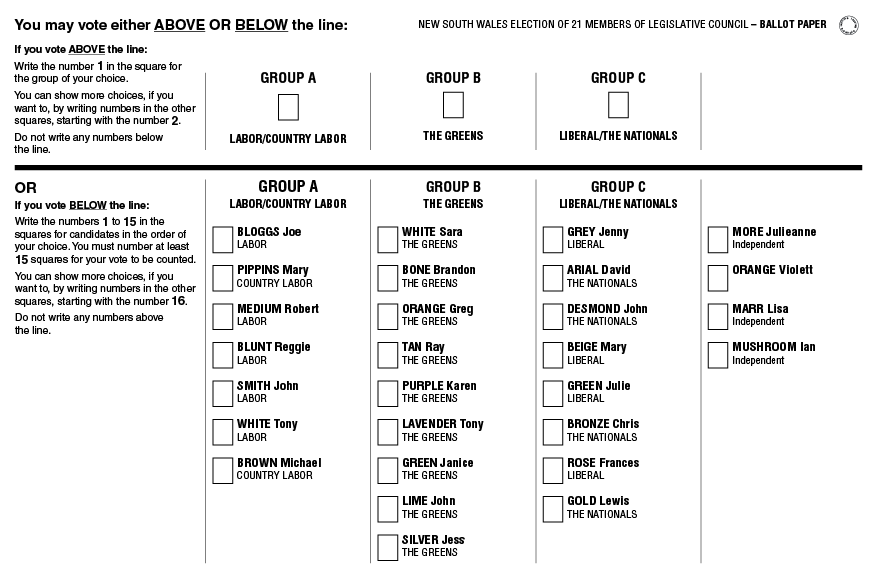
Sample ballot paper supplied by the NSW Electoral Commission
Electors may vote for Members of the Legislative Council in one of two ways:
Vote above the line: The voter has the choice of group voting (usually for a particular party). This is done above the line. The voter places the number “1” in one of the squares to indicate the political party selected as the first choice. Independents are also listed above the line. The political party candidates are shown below the line in the order which the party has selected them.
Alternatively voters can choose to vote for more than one group above the line. You may record the number “1” in the square next to the name of the group of their first choice. Then vote “2” for your second preference and so forth for as many choices as you wish to make.
OR
Vote below the line: The voter has the choice of individual voting (for individual candidates) by placing the numbers “1” to “15” in the squares opposite the names of fifteen candidates in order of preference. The voter can add more candidates ensuring consecutive numbers are used in the squares opposite candidates’ names.
Each of the 21 candidates require a “quota” of votes with typically 4.55% of the total valid primary votes being sufficient for a candidate to gain a seat in the Legislative Council. If fewer than 21 candidates receive a quota, a process of transferring preferences from the candidates with the least primary votes begins until all vacancies are filled. The count and distribution of preferences are conducted using the NSW Electoral Commission’s computer system.
Achieving a final result is complex, as surplus votes (i.e. those a candidate receives above the quota of 4.55%) are redistributed to other candidates using a formula, and this process continues until all 21 Members of the Legislative Council have been elected.
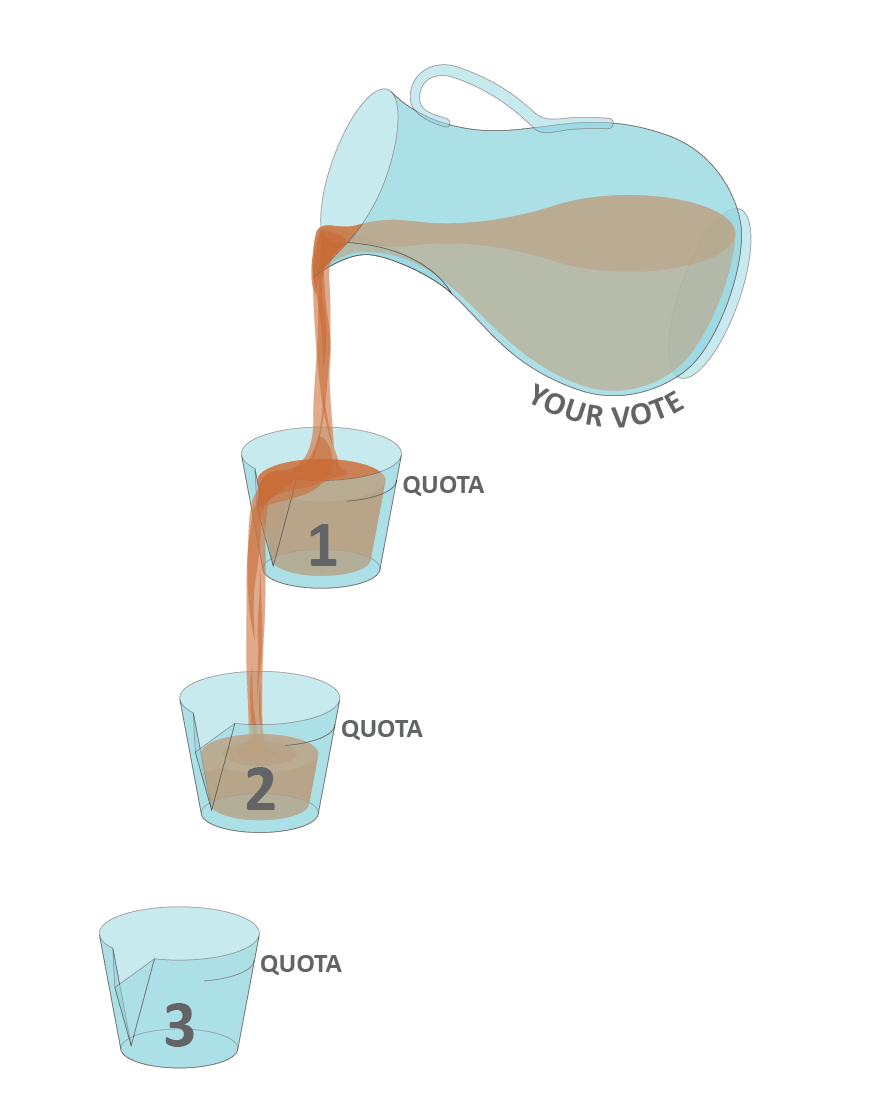
|
Surplus Votes For example, if you imagine that your vote is like a jug of water. If the candidate who was your first preference already has the required quota (4.55%) your vote will spill over to help your second preference who may end up with the required quota in the final count. |
The ballot papers for the Legislative Council are then forwarded to the Electoral Commissioner for safekeeping until the period has expired during which the election can be disputed in the Supreme Court (acting as the Court of Disputed Returns) i.e. within 40 days of the return of the writ or, if a petition has been filed, the Court of Disputed Returns has made a determination, or the period of 6 months after the day of polling has expired.
The Parliamentary Electorates and Elections Act 1912 (NSW) contains information about how elections are conducted in NSW. Read it here
The Constitution Act 1902 (NSW) provides for when elections are to be held in NSW – fourth Saturday in March every four years. NSW has had fixed election terms since 1995. Read it here.
Electoral Act 2017 (NSW) Part 7 sets out particular duties of the Electoral Commissioner throughout the electoral process. Read it here.
Electoral Funding Act 2018 (NSW) new category of unlawful political donation over $100 in cash. Read it here.



